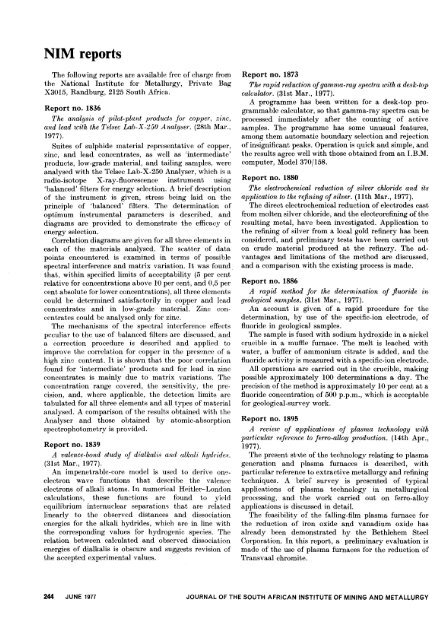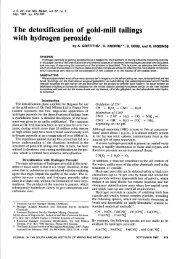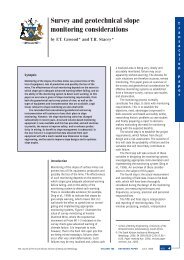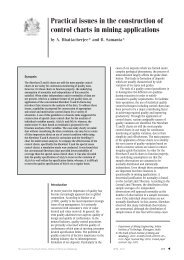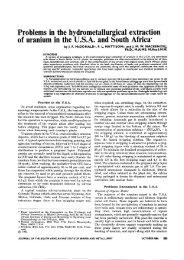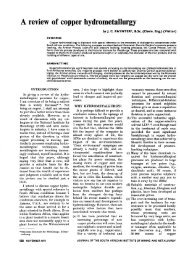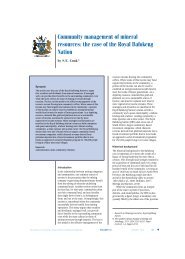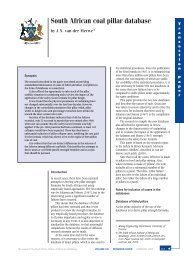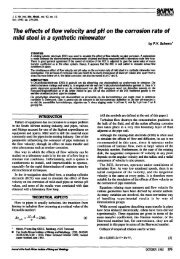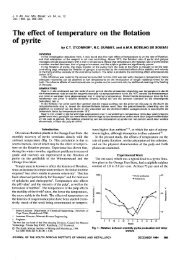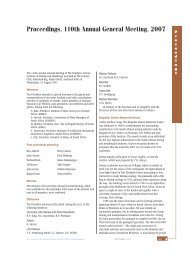General Meeting and Colloquium Coal research - saimm
General Meeting and Colloquium Coal research - saimm
General Meeting and Colloquium Coal research - saimm
You also want an ePaper? Increase the reach of your titles
YUMPU automatically turns print PDFs into web optimized ePapers that Google loves.
NIM reports<br />
The following reports are available free of charge from<br />
the National Institute for Metallurgy, Private Bag<br />
X3015, R<strong>and</strong>burg, 2125 South Africa.<br />
Report no. 1836<br />
The analysis of pilot-plnnt products for copper, zinc,<br />
nnd lead with the Telsec Lab-X-~5U AnalY8er. (28th Mar.,<br />
1977).<br />
Suites of sulphide material representative of copper,<br />
zinc, <strong>and</strong> lead concentrates, as well as 'intermediate'<br />
products, low-grade material, <strong>and</strong> tailing samples, were<br />
analysed with the Telsec Lab-X-250 Analyser, which is a<br />
radio-isotope X-ray-fluorescence instrument using<br />
'balanced' filters for energy selection. A brief description<br />
of the instrument is given, stress being laid on the<br />
principle of 'balanced' filters. The determination of<br />
optimum instrumental parameters is described, <strong>and</strong><br />
diagrams are provided to demonstrate the efficacy of<br />
energy selection.<br />
Correlation diagrams are given for all three elements in<br />
each of the materials analysed. The scatter of data<br />
points encountered is examined in terms of possible<br />
spectral interference <strong>and</strong> matrix variation. It was found<br />
that, within specified limits of acceptability (5 per cent<br />
relative for concentrations above 10 per cent, <strong>and</strong> 0,5 per<br />
cent absolute for lower concentrations), all three elements<br />
could be determined satisfactorily in copper <strong>and</strong> lead<br />
concentrates <strong>and</strong> in low-grade material. Zinc concentrates<br />
could be analysed only for zinc.<br />
The mechanisms of the spectral interference effects<br />
peculiar to the use of balanced filters are discussed, <strong>and</strong><br />
a correction procedure is described <strong>and</strong> applied to<br />
improve the correlation for copper in the pres~mce of a<br />
high zinc content. It is shown that the poor correlation<br />
found for 'intermediate' products <strong>and</strong> for lead in zinc<br />
concentrates is mainly due to matrix variations. The<br />
concentration range covered, the sensitivity, the precision,<br />
<strong>and</strong>, where applicable, the detection limits are<br />
tabulated for all three elements <strong>and</strong> all types of material<br />
analysed. A comparison of the results obtained with the<br />
Analyser <strong>and</strong> those obtained by atomic-absorption<br />
spectrophotometry is provided.<br />
Report no. 1839<br />
A valence-bond study (~f dialkalis <strong>and</strong> nlkali hydrides.<br />
(31st Mar., 1977).<br />
An impenetrable-core model is used to derive on':)-<br />
electron wave functions that describe the valence<br />
electrons of alkali atoms. In numerical Heitler-London<br />
calculations, these functions are found to yield<br />
equilibrium internuclear separations that are related<br />
linearly to the observed distances <strong>and</strong> dissociation<br />
energies for the alkali hydrides, which are in line with<br />
the corresponding values for hydrogenic species. The<br />
relation between calculated <strong>and</strong> observed dissociation<br />
energies of dialkalis is obscure <strong>and</strong> suggests revision of<br />
the accepted experimental values.<br />
Report no. 1873<br />
The rapid reduction of gamma-ray spectra with a desk-top<br />
calculator. (31st Mar., 1977).<br />
A programme has been written for a desk-top programmable<br />
calculawr, so that gamma-ray spectra can be<br />
processed immediately after the counting of active<br />
samples. The programme has some unusual features,<br />
among them automatic boundary selection <strong>and</strong> rejection<br />
of insignificant peaks. Operation is quick <strong>and</strong> simple, <strong>and</strong><br />
the results agree well with those obtained from an I.B.M.<br />
computer, Model 370/158.<br />
Report no. 1880<br />
The electrochemical reduction of silver chloride <strong>and</strong> its<br />
application to the refining of silver. (llth Mar., 1977).<br />
The direct electrochemical reduction of electrodes cast<br />
from molten silver chloride, <strong>and</strong> the electrorefining of the<br />
resulting metal, have been investigated. Application to<br />
the refining of silver from a local gold refinery has been<br />
considered, <strong>and</strong> preliminary tests have been carried out<br />
on crude material produced at the refinery. The advantages<br />
<strong>and</strong> limitations of the method are discussed,<br />
<strong>and</strong> a comparison with the existing process is made.<br />
Report no. 1886<br />
A rapid method for the determination of fluoride in<br />
geological samples. (31st Mar., 1977).<br />
An account is given of a rapid procedure for the<br />
determination, by use of the specific-ion electrode, of<br />
fluoride in geological samples.<br />
The sample is fused with sodium hydroxide in a nickel<br />
crucible in a muffle furnace. The melt is leached with<br />
water, a buffer of ammonium citrate is added, <strong>and</strong> the<br />
fluoride activity is measured with a specific-ion electrode.<br />
All operations are carried out in the crucible, making<br />
possible approximately 100 determinations a day. The<br />
precision ofthe method is approximately 10 per cent at a<br />
fluoride concentration of 500 p.p.m., which is acceptable<br />
for geological-survey work.<br />
Report no. 1895<br />
A review of applications of plasma technology with<br />
particular reference to ferro-alloy prod11ction. (14th Apr.,<br />
1977).<br />
The present st:\te of the technology relating to plasma<br />
generation <strong>and</strong> plasma furnaces is described, with<br />
particular reference to extractive metallurgy <strong>and</strong> refining<br />
techniques. A brief survey is presented of typical<br />
applications of plasma technology in metallurgical<br />
processing, <strong>and</strong> the work carried out on ferro-alloy<br />
applications is discussed in detail.<br />
The feasibility of the falling-film plasma furnace for<br />
the reduction of iron oxide <strong>and</strong> vanadium oxide has<br />
already been demonstrated by the Bethlehem Steel<br />
Corporation. In this report, a preliminary evaluation is<br />
made of the use of plasma furnaces for the reduction of<br />
Transvaal chromite.<br />
244 JUNE 1977 JOURNAL OF THE SOUTH AFRICAN INSTITUTE OF MINING AND METALLURGY


